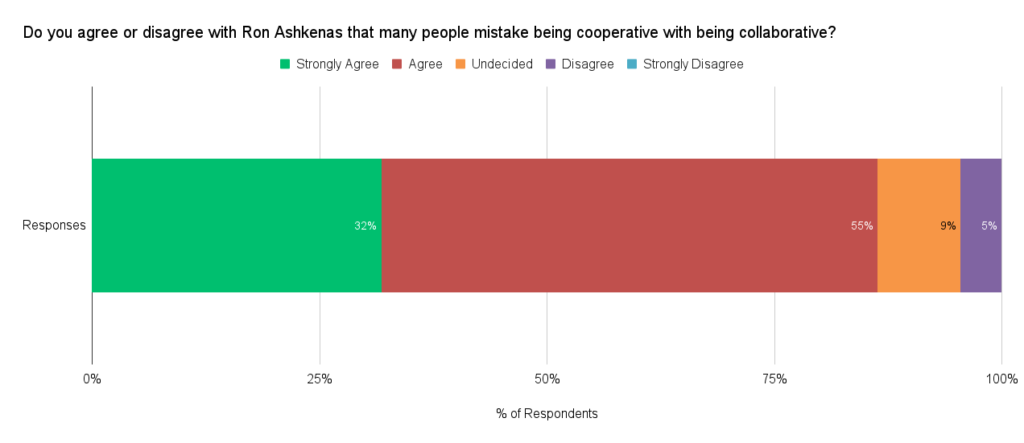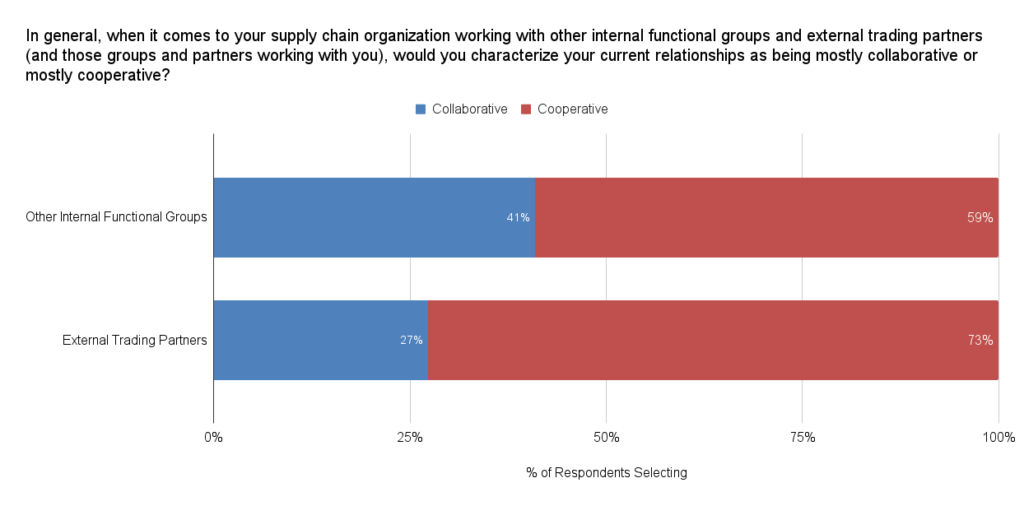In an April 2015 Harvard Business Review article titled “There’s a Difference Between Cooperation and Collaboration,” Ron Ashkenas writes, “Having worked with hundreds of managers over the years, I’ve seen that very few admit to being poor collaborators, mostly because they mistake their cooperativeness for being collaborative.”
What’s the difference between the two?
Per Corey Moseley, “Collaboration is when a group of people come together and work on a project in support of a shared objective, outcome, or mission [it implies shared ownership and interest in a specific outcome], while Cooperation is when a group of people work in support of another’s goals [e.g., you help me on something I’m working on and that I’m ultimately responsible for].”
Do you agree or disagree with Ron Ashkenas that many people mistake being cooperative with being collaborative?
We asked members of our Indago supply chain research community — who are all supply chain and logistics executives from manufacturing, retail, and distribution companies — that question in a September 2023 survey.
Almost a third of our member respondents (32%) “Strongly Agreed” with Ron Ashkenas that many people mistake being cooperative with being collaborative; another 55% “Agreed” with the statement, while only 5% “Disagreed.”

When it comes to working with other internal functional groups and external trading partners, more than half the respondents characterized those relationships as mostly “Cooperative.” That said, while 41% of the respondents view their working relationships with internal functional groups as mostly “Collaborative,” only 27% say the same about their relationships with external trading partners.

“Internally, we collaborate all the time to meet the shared objectives of the company,” said one Indago supply chain executive. “Externally, it is more cooperative. When dealing with freight carriers, if we truly collaborated, we would pay higher rates for dedicated capacity and the carrier would always pick up [our shipment] even if the rate was not enough. Instead, we cooperate to achieve the end goal of delivering the product.”
Here are some other value-added comments from our members:
“I think [the difficulty in establishing true collaborative relationships] stems from not understanding the values and differences between collaboration and cooperation. It is very easy to think that you are collaborating without realizing that you are simply helping another achieve their goal; this does not mean you are aligned with them and their goals. Establishing true collaborative relationships with external trading partners can be difficult because you need to align on common goals and expectations.”
“Collaboration requires a much bigger commitment than cooperation: time together, mapping end-to-end processes, data sharing and analytics,” “Trust, similar cultures, shared objectives, and executive commitment are necessary for collaboration.”
“Collaboration is difficult between internal stakeholders as they often have conflicting KPIs or objectives. Since every function tries to maximize their functional outputs rather than overall performance, cooperation works best. However, the collaborative approach works better with external trading partners as both of us have an aligned objective and purpose.”
We also asked our members, “What are the most important factors for creating a successful collaborative relationship?” For insights on that question and more, Indago members can download the report from our website.
What’s your experience or perspective related to collaborating with other functional groups and trading partners versus cooperating with them? In what cases is collaboration the better approach? Why is establishing true collaborative relationships, especially with external trading partners, so difficult? Post a comment and share your perspective.
Be Uncommon. Research with Purpose.
If you’re a supply chain or logistics practitioner from a manufacturing, retail, or distribution company — and you’re interested in learning from your peers — I encourage you to learn more about Indago and join our research community. It is confidential, there is no cost to join and the time commitment is minimal (2-4 minutes per week) — plus your participation will help support charitable causes like JDRF, American Logistics Aid Network, American Cancer Society, Feeding America, and Make-A-Wish.











